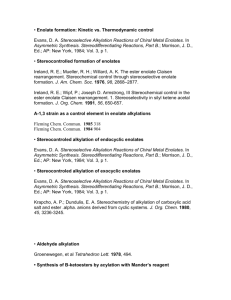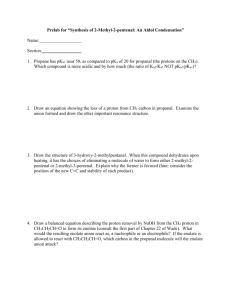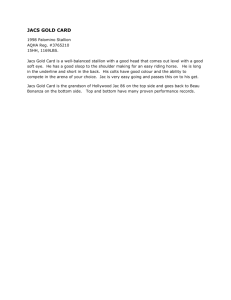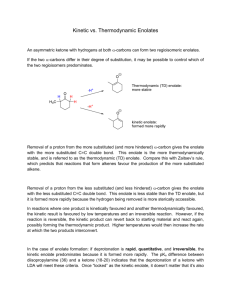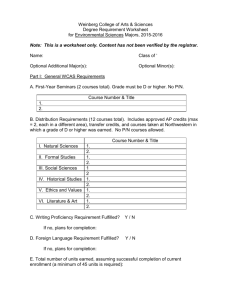Chem 206 D. A. Evans Enolates & Metalloenamines
advertisement
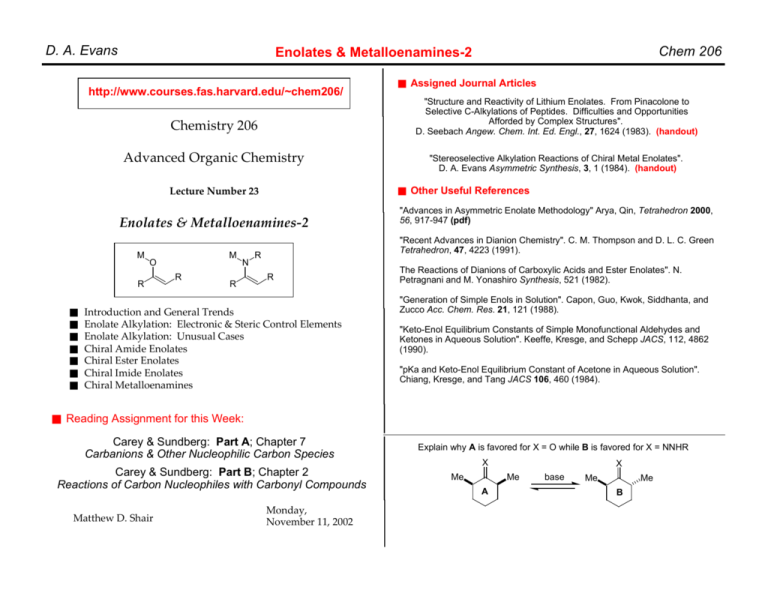
D. A. Evans http://www.courses.fas.harvard.edu/~chem206/ Advanced Organic Chemistry Enolates & Metalloenamines-2 M O R R N R "Stereoselective Alkylation Reactions of Chiral Metal Enolates". D. A. Evans Asymmetric Synthesis, 3, 1 (1984). (handout) ■ Other Useful References Lecture Number 23 M ■ Assigned Journal Articles "Structure and Reactivity of Lithium Enolates. From Pinacolone to Selective C-Alkylations of Peptides. Difficulties and Opportunities Afforded by Complex Structures". D. Seebach Angew. Chem. Int. Ed. Engl., 27, 1624 (1983). (handout) Chemistry 206 ■ ■ ■ ■ ■ ■ ■ Chem 206 Enolates & Metalloenamines-2 "Advances in Asymmetric Enolate Methodology" Arya, Qin, Tetrahedron 2000, 56, 917-947 (pdf) "Recent Advances in Dianion Chemistry". C. M. Thompson and D. L. C. Green Tetrahedron, 47, 4223 (1991). R R Introduction and General Trends Enolate Alkylation: Electronic & Steric Control Elements Enolate Alkylation: Unusual Cases Chiral Amide Enolates Chiral Ester Enolates Chiral Imide Enolates Chiral Metalloenamines The Reactions of Dianions of Carboxylic Acids and Ester Enolates". N. Petragnani and M. Yonashiro Synthesis, 521 (1982). "Generation of Simple Enols in Solution". Capon, Guo, Kwok, Siddhanta, and Zucco Acc. Chem. Res. 21, 121 (1988). "Keto-Enol Equilibrium Constants of Simple Monofunctional Aldehydes and Ketones in Aqueous Solution". Keeffe, Kresge, and Schepp JACS, 112, 4862 (1990). "pKa and Keto-Enol Equilibrium Constant of Acetone in Aqueous Solution". Chiang, Kresge, and Tang JACS 106, 460 (1984). ■ Reading Assignment for this Week: Carey & Sundberg: Part A; Chapter 7 Carbanions & Other Nucleophilic Carbon Species Carey & Sundberg: Part B; Chapter 2 Reactions of Carbon Nucleophiles with Carbonyl Compounds Matthew D. Shair Monday, November 11, 2002 Explain why A is favored for X = O while B is favored for X = NNHR X Me X Me A base Me Me B D. A. Evans ■ Metalloenamines: Decreasing Nucleophilicity Imines may be transformed into their conjugate bases (enolate counterparts) with strong bases: R pKa~ 29-33 Chem 206 Enols, Enolates, Enamines & Metalloenamines: Reactivity Hierarchy N R-MgX The usual bases employed are either lithium amides (LDA) or Grignard reagents. Note that Grignard reagents do not add to the C=N pi-bond due to the reduced dipole. With this functional group, deprotonation is observed to be the preferred reaction. Metalloenamines are significantly more nucleophilic than ketone or aldehyde enolates. They are used when less reactive electrophiles are under consideration. For example: OLi O Me Me X no reaction syn relationship Me However: Metal R I Me N N R Me Me good yield Decreasing Electrophilicity ■ When to use a metalloenamine: C C NR2 C C OMe C C Br2, O3 + + + + H3O+ + + + + O R C Cl + + + O R C H + + + O R C R + + + + + + Me I O R C OR O H2 C Metalloenamines are reactive enough to open epoxides in good yield. Ketone enolates are only marginally reactive enough for this family of electrophiles. C O– Electrophile N Li-NR2 – NR C R R Metal N Nucleophile Me2CH CH2 I + + O Li-NR2 N Me R N Li CH2 OH N R O R C NR2 ■ Nature uses enamines, "stabilized" enolates, and enol derivatives in C–C bond constructions extensively. D. A. Evans C versus O Enolate Reactivity & the Hammond Postulate Question: Why do we generally show enolates reacting with electrophiles at carbon as opposed to oxygen ?? Let's begin the the discussion with an observation: ■ "As electrophile reactivity increases, the percentage of reaction at the enolate oxygen increases." For example, consider the reactions of cyclohexanone enolate with the two electrophiles, methyl iodide and the much more reactive acetyl chloride: O– O–El Chem 206 The Hammond Postulate is also relevant to this issue and is broadly used to make qualitative statements about transition state structure. Hammond, JACS 1955, 77, 334 ■ In attempting to grasp the Hammond Postulate, let's consider two extreme reactions, one which is strongly endothermic and one which is strongly exothermic. T‡ El(+) El(+) O Me C Cl O 2 << 1 O :– El Me B C/O Rxn Ratio I >> 1 Strongly Exothermic Reactions ∆H° > 20 kcal/mol B Energy 1 A A Rxn Coordinate ■ The very reactive acid chloride gives almost exclusively the O-acylation product while the less reactive methyl iodide affords the alternate C-alkylation product. These results may be understood in the context of qualitative statements made by Hammond (The Hammond Postulate) and Hine (The Principle of Least Motion) The Principle of Least Motion: "As reactions become more exothermic, the favored reaction becomes that path which results in the least structural (electronic) reorganization." Hammond Postulate "For strongly exothermic reactions, the transition state T‡ looks like reactant(s) e.g. B." ■ As applied to the enolate-electrophile reaction, for very exothermic reactions, e.g. the reaction with acetyl chloride, the transition state for the process will involve little enolate structural reorganization. Hence in this instance the electrophile heads for the site of highest electron density Carey & Sundberg: Part A; Chapter 4, pp217-220 for discussion of Hammond's Postulate See Hine in Advances in Phys. Org. Chem. 1977, 15, 1-61 Since the X-ray data clearly support the picture that resonance structure 1 best represents the enolate structure, highly reactive electrophiles will favor O-attack according to Hine's generalization. Based upon the above discussion draw a detailed mechanism for the protonation of cyclohexanone enolate. O– O H+ D. A. Evans Review Chem 206 Enolate Alkylation: Stereoelectronic Control Elements Evans, D. A. Stereoselective Alkylation Reactions of Chiral Metal Enolates.; Morrison, J. D., Ed.; AP: New York, 1984; Vol. 3, pp 1-110. Stereoelectronic Issues Examples where stereoelectronic factors are dominant Pilli, Tetrahedron, 1999, 55, 13321 ‡ ■ Enolization: Breaking C–H bond must overlap with π∗ C–O in TS ■ Alkylation: Forming C–El bond must overlap with π∗ C–O in TS‡ H R M O C C O base H C M O C R R Issue: Degree of rehybridization in TS‡? C N ‡ H R R M O C El C C H Bn–Br >99:1 Allyl–Br 93:7 Me Boc Me El M O O ratio good illustration of the impact of allylic strain El(+) R R–X Me Boc H R N R–X R LDA RO O Me H N H O LDA Me H Boc N C LiO C H RO H H O R O R–X R H N ■ Cyclohexanone Enolate: El(+) The C19 Angular Methyl Group in the steroid nucleus a H H path A Me3C C R C OLi El(+) H Me3C R R O chair conformation e O OH Me favored e H disfavored El Li Li O R-substituent Me CO2Me Li/NH3 H H R H H H LiO O Me-I R Me3C El OH Me Me-I O twist boat conformation Metal O Me path E OH Me El Me3C Electrophile Ratio, a:e CD3I Me-I 70:30 83:17 ‡ Chair vs boat geometries not stongly reflected in diastereomeric TS s. The transition states is early and enolate-like. R Me H H H O (90%) one isomer The enolate (Chem 3D) D. A. Evans Enolate Alkylation: Steric Control Elements In this case, both e and a paths are stereoelectronically equivalent. Diastereoselectivity is now determined by the differential steric effects encountered in the two TS‡s. CO2Me OMe Me3C El OLi El H E Me3C -78 °C e CO2Me Steric Effects El(+) a Me3C H H El(+) Electrophile Cases with Opposed steric & electronic effects R R LiO Me O LDA MeI CO2Me H Me El Li/NH3 Ratio, E:A R R El(+) Ratio Dominant Control element Me-I 84:16 –H Et-I 95:05 stereoelectronic n-Bu-Br 87:13 –H CD3I 83:17 stereoelectronic –Me CD3I 07:93 steric –Me Et-I >5:95 steric Me CO2Me Me Ratio, 80 : 20 Me CO2Me O H El Me O Me CO2Me Me + H Me Me R El(+) A Representative cases CO2Me Chem 206 Li The enolate R = Me (Chem 3D) Me CO2Me LDA MeI Ratio, 90 : 10 Me Me Me Based on above data, this case is reasonable: C3H5 O Ph3COCH2 O LDA allyl-Br H O Ph3COCH2 H O Me O H LDA MeI O O H Me However O Ratio, >97 : 3 Me LiNH2 Me-I Ratio, >97 : 3 diastereoselectivity depends stongly on O-protecting group H H CN O (58%) >90 : 10 O NC OTHP Me H CO2Me H Me Me NaH Me-I O H Me Me OTHP (67%) 93 : 7 O Me H CO2Me D. A. Evans Enolate Alkylation: Unusual Cases Cases which do not appear to give the expected product based on the analysis of steric effects Sterically Expected Results: O Me O Me CO2Me O LDA Me O R O Me allyl-Br R C3H5 Chem 206 H N t-Bu O OLi H R = Me, Et, CO2Me N t-Bu OMe BnBr 97% ds MeI >98% ds BzCl >95% ds O CO2Me H O R CO2Me Seebach, Helv. Chim. Acta 1987, 70, 1194. 88 : 12 Contrasteric relatives: Seebach, Angew. Chem. Int. Ed 1981, 20, 1030 Ladner, Angew. Chem. Int. Ed 1982, 21, 449 ■ However: Me CO2Me O Me LDA Me O O t-Bu acetone CO2Me Me O O CO2Me CO2Me OH H Me Me MeO2C Me Me Me O O Me O H O O t-Bu S-t-Bu MeOD >95%ds BnBr 60% ds acetone 95%ds O R COS-t-Bu O Seebach, Helv. Chim. Acta 1987, 70, 1194. ratio, 80 : 20 Li OLi OLi O t-Bu MeI OMe O The enolate (MM-2) O t-Bu Me CO2Me 70 : 30 O Me Me OLi t-Bu Here is another example of a contrasteric alkylation HO2C OH CMe2 t-Bu Me O Me HO2C O Me CO2Me >95 : 5 Me LDA, conditions Ladner, Chem. Ber. 1983, 116, 3413-3426. Me Me (+)-menthol MeI OMe Me O HO2C (+)-menthyl–O2C Me O CO2R X Me CO2R X conditions Ratio R-Cl R-Br THF, 23 °C THF-HMPA -78→-20 °C 80:20 02:98 K. Yamada, Organic Synthesis Past Present, and Future, p 525 Those factors defining olefin face selection are currently being defined: Would you have predicted the outcome of the following reaction? OSiR O R3SiO 3 HgI2 EtO2C EtO OSiR3 Danishefsky J. Org. Chem. 1991, 56, 387 >94 : 6 OSiR3 D. A. Evans Chiral Enolate Enolate Alkylation Circa 1978 Chiral Enolate Design Requirements Circa 1978 Overall enantioselection will be the sum total of the defects introduced through: ■ Enolization selectivity: Amide-based controllers XC limited by enolization selectivity (Lecture 22) Et LM–NR2 Me N R ■ Enolate-electrophile face selectivity OM Ratio, (E):(Z) enolization s-BuLi (THF) Et + N (E) Et H ‡ O Me Et 0 : 100 (Z) ‡ R N Me N Et Me Li H LDA (THF) O N R ■ Racemization attendant with Xc removal XC Et Et Base OLi OLi O ■ Enolization selectivity R Chem 206 Et R N Me O Li H H disfavored N Et Et favored 25 : 75 R XC ■ Amide Based Chiral Auxiliaries Li El(+) CH2OH O Me O O R RO hydrolysis 2 LiNR2 Me N El CH2OH O O El(+) Me N N El R XC El M O With Takacs,Tetrahedron Lett. 1980, 4233 diastereoselection Ca 95 % Allylic Strain controls Enolate Geometry: ■ Enolization selectivity: Ester-based chiral controllers XC limited by enolization selectivity (Lecture 22) RX OLi OLi O Me Base LM–NR2 RX (E) R-Substituent Me + RX H strongly favored O Me C H N H R R O H C R N R Me strongly disfavored (Z) Me Ratio, (E):(Z) Allylic Strain Prevents Product Enolization: El LDA (THF) -OMe, O-t-Bu 95 : 5 LDA (THF) -S-t-Bu 95 : 5 strongly favored O Me C H N H R R O El C R N R Me strongly disfavored D. A. Evans Chiral Amide Enolates Amide Hydrolysis O HOH2C R–X Me (major) N M O Li O HOH2C Chem 206 Enolate Alkylation: Chiral Amide Enolates R R N H+ N O O R R HO Me O M-NR2 CH2OH O O N Me H2N + Me N H O Me R–X R R O HOH2C Me (minor) N HCO3H2O, 5 min O C H O O H OH Me O H2O N H R O Me HN R Evans, Takacs, Tet. Lett. 1980, 21, 4233-4236 intramoleclar general base catalysis Br 96:4 (98%) Br 98:2 (84%) Me Me Chem 3D model Li Applications in Ionomycin synthesis Ionomycin Calcium Complex Li JACS 1990, 112, 5290-5313 Li O H Me O OH Me N 14 O O 14 Me Me OH Ca OH O 17 Me Me H O O O O 1 12 9 Me2HC LDA O R–X The nature of enolate chelation is ambiguous. Nitrogen chelation is a real possibility. Me 14 Me Myers, JACS 1997, 119, 6496 Me O N O 84% Ph PhCH=CHCH2Br Me Me O 14 N O Me Me2HC diastereoselection 99:1 Me Me Me O Me2HC O N OH Me Li O Ph 14 12 N Me Me diastereoselection 97:3 K Li O CH2OH O 83% Ph 14 Me I Me N D. A. Evans O Alkali Metal enolates: O M R LDA O O N N El(+) O or NaNTMS2 Ph O M R enolization selectivity >100:1 O N El(+) O ArCH2Br CH2C=CHCH2Br M = Li, THF < 0 °C M = Na, THF -78 to 0 °C ArCH2OCH2Br marginal reaction CH3CH2I CH3I Enolate Acylation N Me2CH O R O R Cl Et JACS 1987,109, 6881. JACS 1990,112, 4012-4030 Bn diastereoselection 91-99+ % O Bn 50-120 : 1 50 : 1 50 : 1 Me2HC N Tet. 1988, 44, 5525-40 BocHNNBoc Bn diastereoselection 97-99+ % SO2N3 (Trisyl-N3) CHMe2 13 : 1 Enolate Hydroxylation O R O O JACS 1986,108, 3695. N 25 : 1 O O R BocN=NBoc CHMe2 Ratio O O M = Li JACS. 1982,104, 1737. Li–NR2 O N XC Me2CH O M O O El O N HOAc N3 R Alkyl Halide Me XC R El O R2 Trisyl-N3 M=K O R1 O R O O Enolate Amination O Me R Chem 206 Enolate Alkylation: Chiral Imide Enolates JACS 1984, 106, 1154. Me Me2CH Diastereoselection ~ 97 : 3 O O N Me Na enolate is required. Why? O PhHC O NSO2Ph R Na-N(TMS)2 N O OH Ph Me Ph Imide (R) Ratio Yield * PhCH2- 94 : 6 86 % CH2=CHCH2- 95 : 5 91 % 96 : 4 90 : 10 68 % 77 % MeO2CCH2CH2CH2PhMe3C- New stereocenter not lost through enolization O >99 : 1 94 % JACS. 1985,107, 4346. authentic X-ray structure For all indicated rxns, as the R on the enolate grp increases in size enolate-El face selectivity increases. Explain. D. A. Evans Enolate Alkylation: Chiral Ester Enolates Chiral Ester Enolates Helmchen, Angew. Chem. Int.Ed. 1981, 20, 207-208 Me Me Li N Me (LiCHIPA) THF Me H Me O Me LiCHIPA THF, HMPA 4:1 Me Me SO2Ph N Me LiO Me Me Me El Koga, JACS 1984, 106, 2718-2719 El(+) Ratio H O Me OMe addend Yield Ratio (A:B) THF 63% 96:04 Me–I HMPT THF HMPT 57% 01:99 48% 99:01 77% 15:85 n-C14H29–I n-C14H29–I 98.5:1.5 06:94 enolate contamination Chiral β-Keto Ester Dienolates Me Me Me Me OLi N Me Me SO2PhH N X O KO-t-Bu Me H O O El(+) N O O Major diastereomer Me Me Me t-BuLi Br O Me Helmchen,Tet. Lett. 1983, 24, 3213-3216 Me El Me–I Bn-Br O H Me N B Bn-Br Helmchen, Angew. Chem. Int.Ed. 1984, 23, 60-61 Helmchen,Tet. Lett. 1983, 24, 1235-1238 O OMe El(+) SO2Ph N El X O Me (Z) SO2Ph N A CO2t-Bu Rationalize the effect of HMPA on the stereochemical outcome of reaction. Me O (E) Me O HMPT LiO Me (Z)-enolate Me SO2Ph N Me X O O OMe Me2HC El(+) enolate Me toluene N Me H Me H Me2HC LDA Li El Me El(+) Me O N THF O O (E)-enolate Me NH OMe SO2Ph N H H H Me2HC Me O Me CO2t-Bu RO CO2t-Bu R Me Chiral β-Keto Ester Enolates Me2HC SO2Ph N O Me Chem 206 E(+) = Me–I, Et–I, Bn–Br diastereoselection 98% Me Me O Rationalize the stereochemical outcome of reaction. N O H Ratio, 93:7 (74%) Helmchen,Tet. Lett. 1985, 26, 3319-3322 Me Schlessinger,Tet. Lett. 1988, 29, 1489-1492 D. A. Evans O O OTs Me EtO LiNR2 n-C4H9 LiNR2 MeI Me3Si diastereoselection 98:2 diastereoselection 89:11 diastereoselection R = Me R = Et 87:13 80:20 R = CHMe2 40:60 Ph D. Kim & Co-workers, Tetrahedron Lett. 1986, 27, 943. Ph O LiNR2 Me3Si MeO O RO2C LiNR2 OBn OBn diastereoselection 90:10 at C3 one isomer at C2 Me O RO2C H O H Me3Si Me–CHO 71% yield MeO major diastereomer opposite to that shown I. Fleming & Co-workers, Chem. Commun. 1985, 318. Y. Yamamoto & Co-workers, Chem. Commun. 1984, 904. H H OMe R R-substituent Me EtO n-C4H9 O Me3Si OMe R H O Ph OM NH4Cl EtO O EtO Ph Me n-C4H9 H n-C4H9 Chem 206 Allylic Strain & Enolate Diastereoface Selection OH I. Fleming & Co-workers, Chem. Commun. 1986, 1198. "one isomer" Br H CO 2Me H CO 2Me 95% yield Me G. Stork & Co-workers, Tetrahedron Lett. 1987, 28, 2088. Bn O Me S N N S TBSOCH2 MeI H CO2Me S N S diastereoselection >95% OH T. Mukaiyama & Co-workers, Chem. Letters 1986, 637 TBSOCH2 "one isomer" Me H O N Boc R 91-95% Me CH2 LiNR2 Bn R–CHO Boc Me CH2 Sn(OTf)2 H H CO 2Me O Me OMe (MeS)3C–Li Me–I 86% T. Money & Co-workers, Chem. Commun. 1986, 288. MeS MeS Me O OMe diastereoselection 99:1 MeS Me K. Koga & Co-workers, Tetrahedron Letters 1985, 26, 3031. R R OM O MeI PhMe2Si OEt PhMe2Si OEt Me R = Me: diastereoselection 99:1 R = Ph: diastereoselection 97:3 I CO2Et OLi R KOt-Bu THF -78 °C I. Fleming & Co-workers, Chem. Commun. 1984, 28. H O-t-Bu CO2Et R = H: one isomer CO2-t-Bu R = Me: > 15 :1 H R Y. Yamaguchi & Co-workers, Tetrahedron Letters 1985, 26,1723. D. A. Evans Chem 206 Metalloenamines-1 ■ Representative Reactions: ■ Seminal Paper: Stork & Dowd, JACS, 1963, 85, 2178-2180 Me Me ■ Reviews: H3O+ Et–MgCl Martin in Comprehensive Organic Synthesis, 1991; Vol 2, Chapter 1.16, pp 475-502 Whitesell Synthesis, 1983, 517-535 Bregbreiter in Asymmetric Synthesis, 1983; Vol 2, Chapter 9, pp 243-273 Enders in Asymmetric Synthesis, 1984; Vol 3, Chapter 4, pp 275-339 Me Me2CH–I N conditions: base + R-X in refluxing THF N ∆ O 60% overall Me Me Me Me ■ Generation & Structure: M pKa~ 29-33 N R N R N Et–MgCl Me H3O+ 83% overall Me–I El El(+) (Z) anion R N syn product O Me Me H base The base: R–Li; RMgX; R2N–Li Me R N R M El(+) (E) anion CMe3 H3O+ n-Bu–Br Me O Stork & Dowd, JACS, 1963, 85, 2178-2180 El anti product ■ Nature of N-substituent, base, and solvent additive can play a role in deprotonation regioselectivity: Hosomi, JACS, 1982, 104, 2081-2082 Me + base Fraser, JACS 1978, 100, 7999 Fraser, Chem. Commun. 1979, 47 N R H3O + Me–I Me N R nonbonding N-lone pair may be stabilized by delocalizatin into antibonding orbital of C=C. Remember, (Z) geometry also favored for enol ethers base –cyclohexyl s-BuLi –NMe2 s-BuLi Collum, JACS 1984, 106, 4865-4869 Collum, JACS 1985, 107, 2078-2082 Collum, JACS 1986, 108, 3415-3422 Collum, JACS 1993, 115, 789-790 N Me R base Me H3O+ Bn–Br ratio 10:90 100:0 O O Bu Bu Bn R + 1 equiv HMPA Me Me Me ■ Solid State & Solution Structure: ■ Geometry Rationalization: O O R X-ray structure reveals the following: ❐ Anion geometry is (Z) ❐ For M = Li, anion is delocalized rather than localized as pictured 60% overall Me H3O+ N Acidity Measurements: (Streitwiser, JOC 1991, 56, 1989; Fraser, ibid. 1985, 50, 3234): Kinetic product geometry strongly favors the syn isomer (>99%) (Fraser) N Et–MgCl Me Bn base ratio –cyclohexyl s-BuLi 74:26 –cyclohexyl s-BuLi 100:0 D. A. Evans Stereoelectronic Issues: N Chem 206 Metalloenamines-2 Li Bn N Chiral Metalloenamines: Bn H LDA MeI H Me Me3C Meyers, J. Am. Chem. Soc 1976, 98, 3032 Whitesell, J. Org. Chem. 1978, 42, 377-378 full papers: Meyers, J. Org. Chem 1978, 43, 892 Meyers, J. Am. Chem. Soc 1981, 103, 3081 Meyers, J. Am. Chem. Soc 1981, 103, 3088 H Me3C H Me X CMe3 CMe3 early papers: X Ratio, 97:3 R2 Fraser, JACS 1978, 100, 7999 R2 O O Tendency for axial-chair alkylation is significantly greater that for ketones H Me LDA MeI Me3C H H Me H Me Me3C H NBn N H R1 Me Me3C H M H X Ratio The base: R–Li; RMgX; R2N–Li X = N-Bn 94:06 MeO X=O 60:40 X Fraser, JACS 1978, 100, 7999 N NNMe2 H CN H H Me LDA Me3C MeI NC CMe3 NNMe2 Major Product O El(+) LDA H3O+ Me Me NNMe2 Collum, JACS 1984, 106, 4865-4869 Me H H Me N H Me H MeI R–X ee Me–I 87 Et–I n-Pr–I 94 99 Chiral Metallated Hydrazones Me LDA El El(+) Meyers, J. Am. Chem. Soc 1981, 103, 3081 NNMe2 R El H Me3C N Bn CN Me R1 base Me X N NNMe2 Me NNMe2 N N N CH2OMe LDA R CH2OMe R–X Ratio, 90:10 Enders in Asymmetric Synthesis, 1984; Vol 3, Chapter 4, pp 275-339 Metalloenamine X-ray Structures D. A. Evans, K. Scheidt Chem 206 LI LI Li LI Me Li N N Me H Li N H LI LI Collum & Clardy, JACS 1984, 106, 4865 LI D. A. Evans SAMP-Metalloenamine X-ray Structure Chem 206 Chiral Metallated Hydrazones Me N N Li LDA MeO O N N THF deleted N N R–X R CH2OMe Li Me H N N Li R R O Me A (Enders) O H N N Li R R diastereotopic face attacked by El(+) B Which of the reactive chelate conformations are we to begin our analysis from? Li diastereotopic face attacked by El(+) For a review of this methodology see Enders, D. in Asymmetric Synthesis.; Morrison, J. D., Ed.; AP: New York, 1984; Vol. 3, p 275-339.
